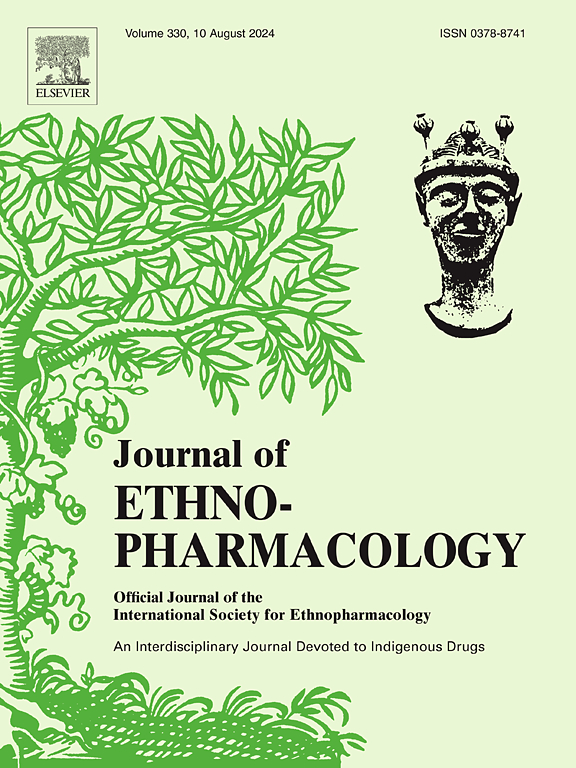IF 4.8
2区 医学
Q1 CHEMISTRY, MEDICINAL
引用次数: 0
摘要
民族药理学意义:Aconitum carmichaelii Debx.对心力衰竭、炎症和疼痛有显著疗效,但其临床应用因同时存在心脏毒性和神经毒性而受到限制。乌头碱(AC)是生物活性最强的生物碱,其治疗窗口狭窄,毒性和治疗阈值明确。然而,介导乌头碱的双重毒性和疗效的重叠分子靶点仍然特征不清:本研究旨在通过整合药理学和转基因小鼠模型评估 AC 的双重药理和毒理作用:基于整合药理学确定了AC相关毒性/药效的重叠靶点。通过产生表达人 CYP3A4(hCYP3A4)的 Cyp3a-/- 转基因小鼠、Ugt1、P-gp、Mrp2、BCRP 和 Nrf2 基因敲除小鼠,评估了 AC 对毒性、疼痛、炎症和心力衰竭的影响:结果:我们发现了 143 个重叠靶点,这些靶点主要集中在代谢通路中。与 WT 小鼠相比,接触 AC 的 hCYP3A4、Mrp2-/-、P-gp-/-、BCRP-/- 和 Nrf2/- 小鼠基于症状的毒性评分显著升高。此外,通过热板试验,AC 还使 hCYP3A4、Mrp2-/-、P-gp-/- 和 Nrf2-/- 小鼠的反应潜伏期分别延长了约 18s、15s、14s 和 5s。有趣的是,毒性评分和镇痛潜伏期都是先上升后下降,在 60 分钟时达到峰值。在 hCYP3A4 小鼠中,AC 能明显降低醋酸诱导的蠕动和渗透性,降幅分别为 45.7% 和 22.2%,而与 WT 小鼠相比,这些变化在 Mrp2-/- 小鼠中被放大。此外,AC可减轻DOX诱导的hCYP3A4小鼠心力衰竭,有效率为20.9%,Septin4与AC相关的代谢有牵连:结论:代谢靶点可阐明 AC 的毒性和疗效之间的机理重叠。值得注意的是,hCYP3A4 在增强镇痛、抗炎和心脏保护作用的同时,还表现出更强的毒性。我们的研究结果将代谢途径定位为 AC 相关双重效应的关键节点,并将 Septin4 确定为其代谢调节的候选介质。本文章由计算机程序翻译,如有差异,请以英文原文为准。

CYP3A4 and MRP2 are predominant metabolic regulators attribute to the toxicity/efficacy of aconitine derived from Fuzi
Ethnopharmacological relevance
Aconitum carmichaelii Debx. exhibits overwhelming efficacy against heart failure, inflammation and pain, but its clinical application is limited by concomitant cardiotoxicity and neurotoxicity. Aconitine (AC), the most abundant bioactive alkaloid, has narrow therapeutic window, with well-defined toxic and therapeutic thresholds. However, the overlapping molecular targets mediating dual toxicity and efficacy of AC remain poorly characterized.
Aims of the study
This study aimed to evaluate dual pharmacological and toxicological roles of AC through integrative pharmacology and transgenic mouse models.
Materials and methods
The overlapping targets of AC-related toxicity/efficacy were identified based on integrative pharmacology. By generating Cyp3a−/− transgenic mice expressing human CYP3A4 (hCYP3A4), Ugt1, P-gp, Mrp2, BCRP, and Nrf2 knockout mice, the effects of AC on toxicity, pain, inflammation, and heart failure were assessed.
Results
We identified 143 overlapping targets predominantly enriched in metabolic pathways. Symptom-based toxicity scores were strikingly elevated in AC-exposed hCYP3A4, Mrp2−/−, P-gp−/−, BCRP−/−, and Nrf2−/− mice compared to WT mice. Additionally, AC prolonged the latency of response by approximately 18s, 15s, 14s, and 5s, respectively, in hCYP3A4, Mrp2−/−, P-gp−/−, and Nrf2−/− mice by hot plate assay. Interestingly, both toxicity score and analgesic latency initially increased and subsequently decreased, peaking at 60 min. AC obviously decreased the acetic acid-induced writhing and permeability by 45.7% and 22.2% in hCYP3A4 mice, whereas these changes were amplified in Mrp2−/− mice compared to WT mice. Furthermore, AC attenuated DOX induced heart failure in hCYP3A4 mice, with an effective rate of 20.9%, with Septin4 implicated in AC-related metabolism.
Conclusions
Metabolic targets may elucidate the mechanistic overlap between the toxicity and efficacy of AC. Notably, hCYP3A4 exhibited heightened toxicity, alongside enhanced analgesic, anti-inflammatory, and cardioprotective effects. Our findings position metabolic pathways as critical nodes for AC-related dual effect, and establish Septin4 as a candidate mediator of its metabolic regulation.
求助全文
通过发布文献求助,成功后即可免费获取论文全文。
去求助
来源期刊

Journal of ethnopharmacology
医学-全科医学与补充医学
CiteScore
10.30
自引率
5.60%
发文量
967
审稿时长
77 days
期刊介绍:
The Journal of Ethnopharmacology is dedicated to the exchange of information and understandings about people''s use of plants, fungi, animals, microorganisms and minerals and their biological and pharmacological effects based on the principles established through international conventions. Early people confronted with illness and disease, discovered a wealth of useful therapeutic agents in the plant and animal kingdoms. The empirical knowledge of these medicinal substances and their toxic potential was passed on by oral tradition and sometimes recorded in herbals and other texts on materia medica. Many valuable drugs of today (e.g., atropine, ephedrine, tubocurarine, digoxin, reserpine) came into use through the study of indigenous remedies. Chemists continue to use plant-derived drugs (e.g., morphine, taxol, physostigmine, quinidine, emetine) as prototypes in their attempts to develop more effective and less toxic medicinals.
 求助内容:
求助内容: 应助结果提醒方式:
应助结果提醒方式:


